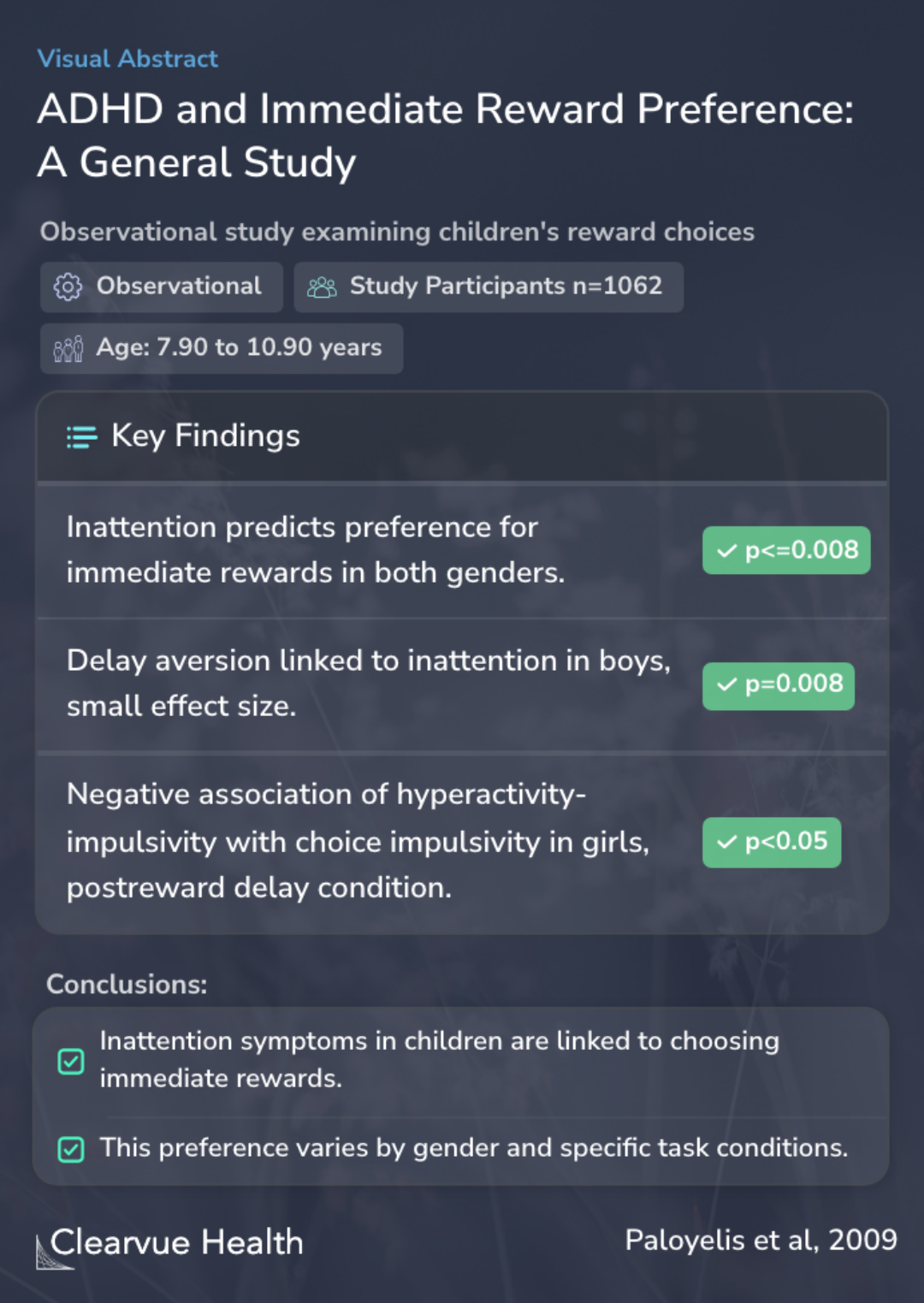Are ADHD symptoms associated with delay aversion or choice impulsivity? A general population study
ADHD and Immediate Reward Preference: A General Study
Paloyelis Y, Asherson P, Kuntsi J

Objectives
The study we're talking about today is really interesting. It focuses on something called "delay aversion". This is a fancy way of saying that some people prefer getting a small reward right now, rather than waiting for a bigger reward later. This is sometimes seen in kids who act without thinking, choosing quick rewards over better ones that they could get if they waited. The researchers wanted to see how this connects to kids with ADHD - Attention-Deficit/Hyperactivity Disorder. They had a guess, based on what's called "delay aversion theory", that ADHD might make kids more likely to choose these immediate, smaller rewards.
The term delay aversion has been used both to describe a behavioral tendency of greater preference for smaller-immediate over larger-delayed rewards (choice impulsivity) and to refer to a secondary explanatory construct put forward by delay aversion theory. In this study, we examined the...
Methods
To figure this out, the scientists did an experiment with 1,062 kids. These kids were between about 8 and 11 years old. They were given a choice between a small reward they could have right away or a bigger one they would get later. This was to test how they make decisions - whether they go for instant gratification or can wait for something better. The kids did this task under two different conditions to see if it changed how they decided.
A total of 1,062 children aged 7.90 to 10.90 years (49% girls) made a fixed number of repeated choices between a smaller reward delivered immediately and a larger reward delivered after a delay (choice-delay task), under two conditions (including and excluding a postreward delay). We ass...
Results
Now, here's what they found: kids who often didn't pay attention, a symptom of ADHD, usually chose the immediate rewards, no matter the situation or if they were boys or girls. However, the desire to avoid waiting, called delay aversion, was mainly seen in boys with inattention issues. The relationship wasn't solid, but it was there. Interestingly, girls who were hyperactive or impulsive (another part of ADHD) were less likely to pick the quick reward if they had to wait afterward. But this wasn't seen in boys.
Inattention ratings uniquely predicted preference for smaller-immediate rewards under both task conditions for both sexes. An index of delay aversion was associated with inattention only in boys; the effect size was small yet significant. Hyperactivity-impulsivity ratings were negatively...
Conclusions
This study is the first to link not paying attention, a crucial part of ADHD, to making quick, sometimes not-so-great choices and trying to avoid waiting for things. It's important because it helps us understand how kids with ADHD think and make decisions. It also points to new ways to help them, like teaching them to wait for better rewards, both in behavior and possibly with medicine. This kind of understanding is crucial for coming up with better ways to help kids with ADHD.
This is the first study to report a unique association between inattention symptoms and behavioral measures of choice impulsivity and delay aversion. The findings indicate the importance of the primary constitutional processes that underlie choice impulsivity and their potential role in ...
Key Takeaways
Context
Talking about impulsivity and ADHD, there's more research out there that you might find interesting. One study from 2005 looked at how kids with ADHD choose between different rewards. It found that these kids often go for the immediate tips, showing they're more impulsive. This is important because it tells us how impulsivity in ADHD kids can affect their choices, which is vital for figuring out how to treat and assess them.
Plus, impulsivity isn't just about decision-making. It can show up in social interactions, like interrupting others, and even in more significant issues like addiction or taking dangerous risks without thinking about what might happen. These studies give a bigger picture of how impulsivity can impact someone's life, especially if they have ADHD.